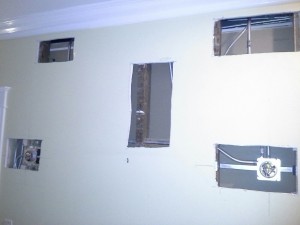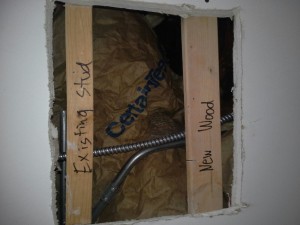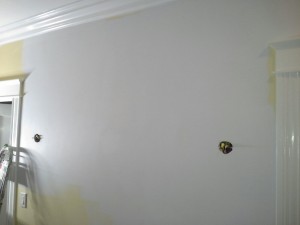Making holes in drywall disappear, as if they never existed, is one of the skills of a competent house painter. As painting and decorating contractors in the Chicago area, we are often called upon to do such repairs after an electrician has added electrical boxes or fixtures to an existing house. This is also a common occurrence when a house is being rewired.
The first picture shows how one of the walls looked when we first came on the premises of a recent project. On that particular project, there were sixteen holes that varied in size from ten square inches to three square feet. Our record is twenty-four holes in the plaster walls of three rooms – ouch! I think the electrician was a bit Sawzall-happy.
How do you go about disappearing a hole in drywall? A drywall patch must be screwed to wood bracing. On occasion, there is a stud nearby that can provide bracing for at least one side of the patch. More commonly, we need to cut pieces of 2×1 wood and screw them to the rear of the existing drywall to create the bracing we need, as shown in the next picture. Sometime, we may need to enlarge the hole or combine it with other holes to make the repairs more efficient. We use our professional judgment to make those calls.
At this point, it is important to ascertain the thickness of the surrounding drywall. In modern construction, walls are clad in 5/8” and ceilings in ½” drywall (but not always). If you have to, you are better off using a thinner piece that a thicker one, as it can be filled in with joint compound. The new drywall piece is then screwed to the wood bracing, taped and patched. A top quality repair will generally require three coats of joint compound and easily cover an area three or four times the original size of the hole. The patch is then ready to be primed. By then, the hole has disappeared!
Repairing holes in drywall is part of the skill-set of a competent house painter. Making it look as if it never happened is the result our clients can expect from us.










 Follow
Follow
